Financial Resource Management Project Report: Orchid Limited Analysis
VerifiedAdded on 2020/05/28
|7
|1548
|28
Project
AI Summary
This project report analyzes the financial performance of Orchid Limited, focusing on cost management and production efficiency. The report calculates various variances, including sales, material, labor, and fixed overhead variances, to evaluate the company's actual performance against its budget. The case study highlights the company's strong market position and successful production of 810 units against an expected 800. The analysis reveals positive sales volume and price variances, indicating strong revenue generation. However, it also points out areas for improvement, such as material price and usage variances, and provides recommendations for future budget preparation based on the findings. The report also evaluates labor and fixed overhead variances, highlighting cost control measures and offering insights into market dynamics. The report is a comprehensive evaluation of Orchid Limited's financial health and offers recommendations for future financial planning.
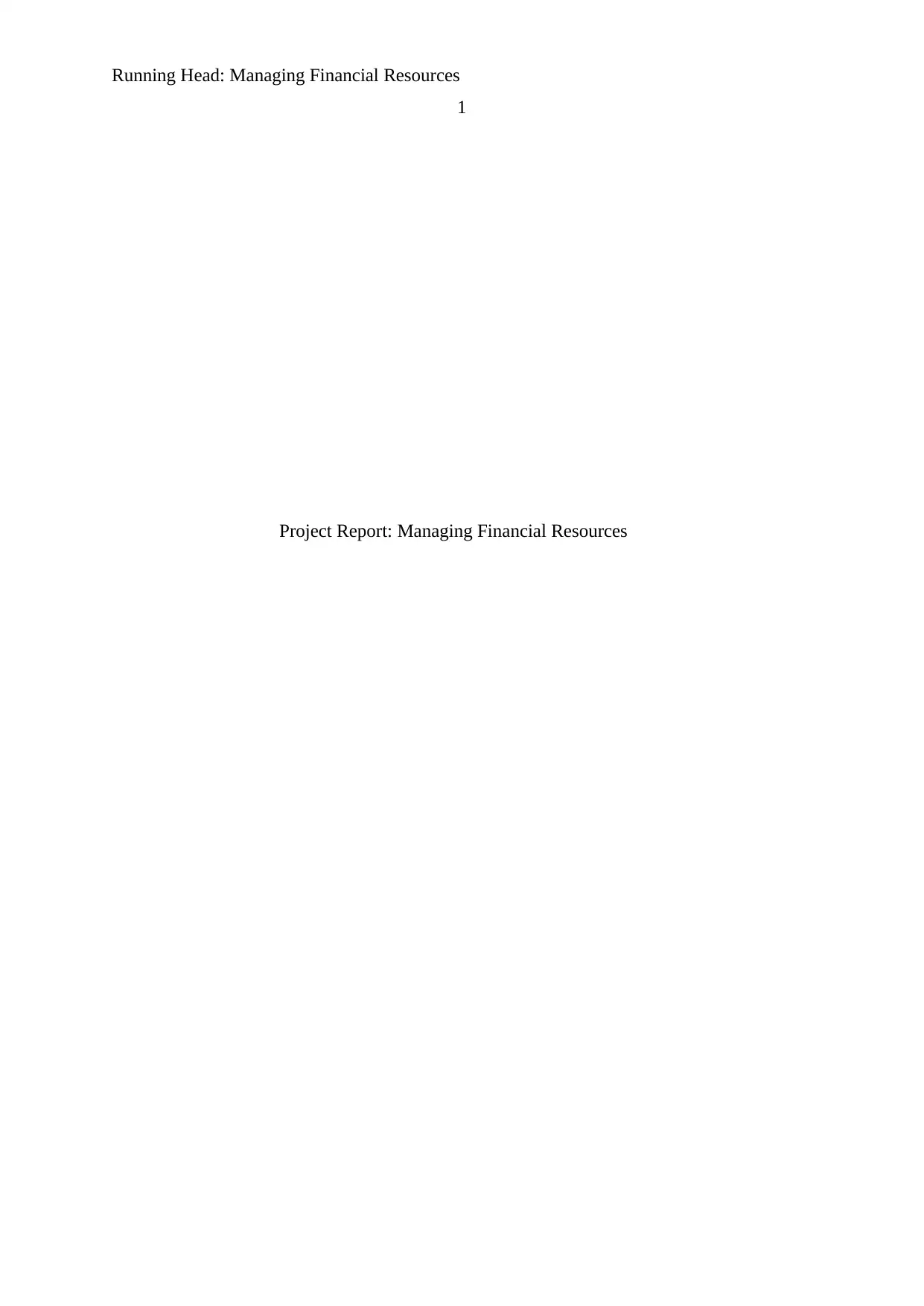
Running Head: Managing Financial Resources
1
Project Report: Managing Financial Resources
1
Project Report: Managing Financial Resources
Paraphrase This Document
Need a fresh take? Get an instant paraphrase of this document with our AI Paraphraser
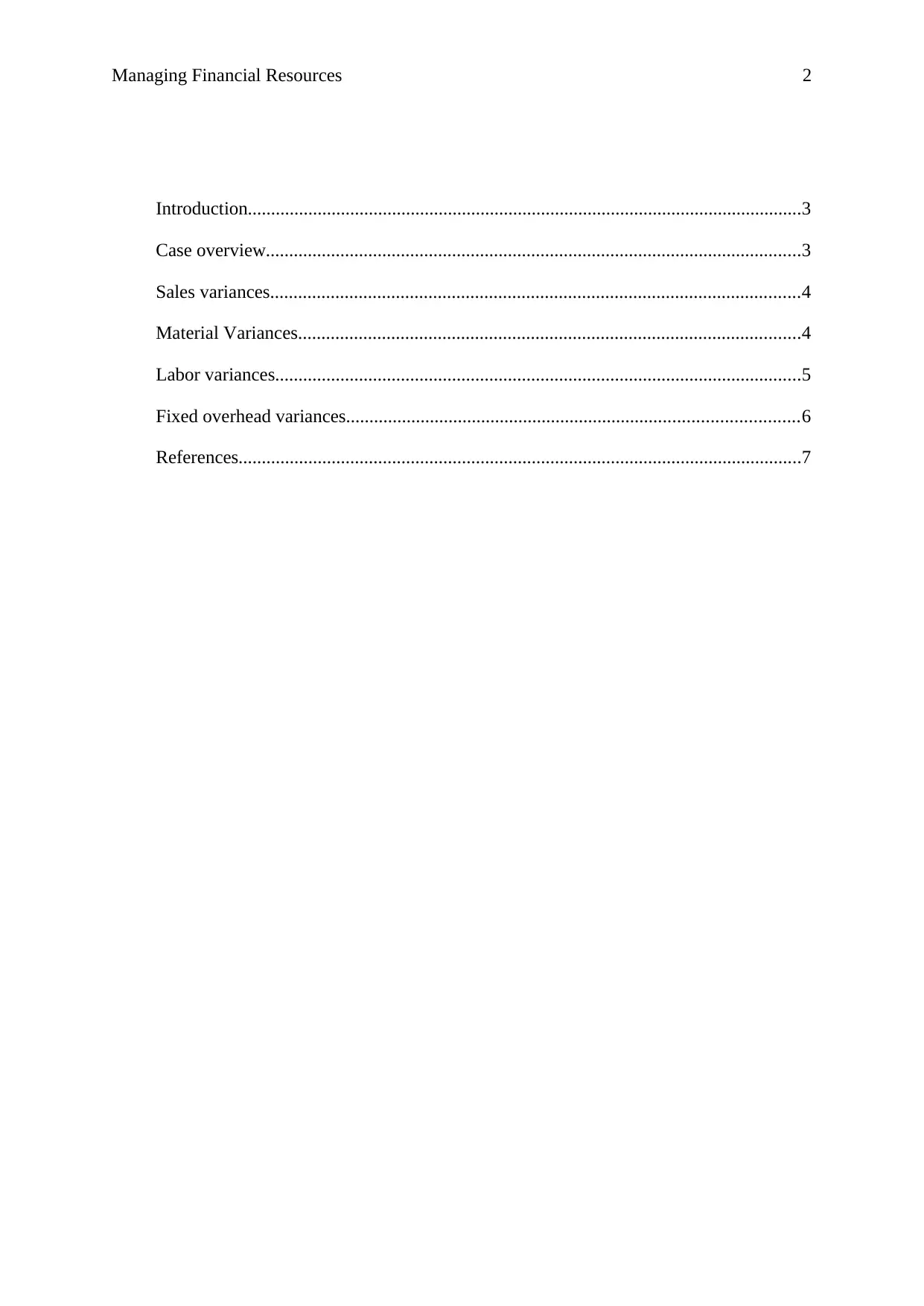
Managing Financial Resources 2
Introduction.......................................................................................................................3
Case overview...................................................................................................................3
Sales variances..................................................................................................................4
Material Variances............................................................................................................4
Labor variances.................................................................................................................5
Fixed overhead variances.................................................................................................6
References.........................................................................................................................7
Introduction.......................................................................................................................3
Case overview...................................................................................................................3
Sales variances..................................................................................................................4
Material Variances............................................................................................................4
Labor variances.................................................................................................................5
Fixed overhead variances.................................................................................................6
References.........................................................................................................................7
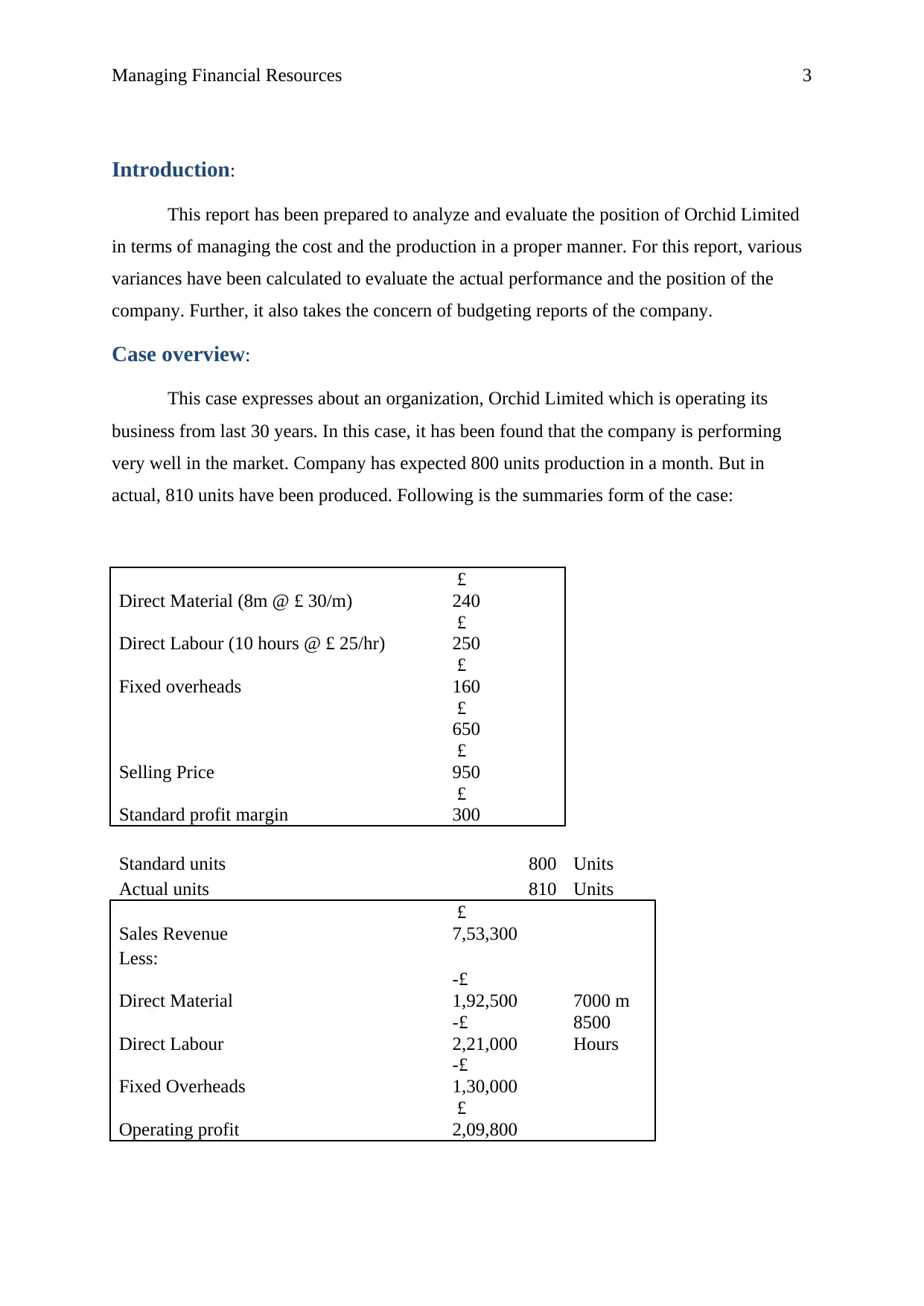
Managing Financial Resources 3
Introduction:
This report has been prepared to analyze and evaluate the position of Orchid Limited
in terms of managing the cost and the production in a proper manner. For this report, various
variances have been calculated to evaluate the actual performance and the position of the
company. Further, it also takes the concern of budgeting reports of the company.
Case overview:
This case expresses about an organization, Orchid Limited which is operating its
business from last 30 years. In this case, it has been found that the company is performing
very well in the market. Company has expected 800 units production in a month. But in
actual, 810 units have been produced. Following is the summaries form of the case:
Direct Material (8m @ £ 30/m)
£
240
Direct Labour (10 hours @ £ 25/hr)
£
250
Fixed overheads
£
160
£
650
Selling Price
£
950
Standard profit margin
£
300
Standard units 800 Units
Actual units 810 Units
Sales Revenue
£
7,53,300
Less:
Direct Material
-£
1,92,500 7000 m
Direct Labour
-£
2,21,000
8500
Hours
Fixed Overheads
-£
1,30,000
Operating profit
£
2,09,800
Introduction:
This report has been prepared to analyze and evaluate the position of Orchid Limited
in terms of managing the cost and the production in a proper manner. For this report, various
variances have been calculated to evaluate the actual performance and the position of the
company. Further, it also takes the concern of budgeting reports of the company.
Case overview:
This case expresses about an organization, Orchid Limited which is operating its
business from last 30 years. In this case, it has been found that the company is performing
very well in the market. Company has expected 800 units production in a month. But in
actual, 810 units have been produced. Following is the summaries form of the case:
Direct Material (8m @ £ 30/m)
£
240
Direct Labour (10 hours @ £ 25/hr)
£
250
Fixed overheads
£
160
£
650
Selling Price
£
950
Standard profit margin
£
300
Standard units 800 Units
Actual units 810 Units
Sales Revenue
£
7,53,300
Less:
Direct Material
-£
1,92,500 7000 m
Direct Labour
-£
2,21,000
8500
Hours
Fixed Overheads
-£
1,30,000
Operating profit
£
2,09,800
⊘ This is a preview!⊘
Do you want full access?
Subscribe today to unlock all pages.

Trusted by 1+ million students worldwide
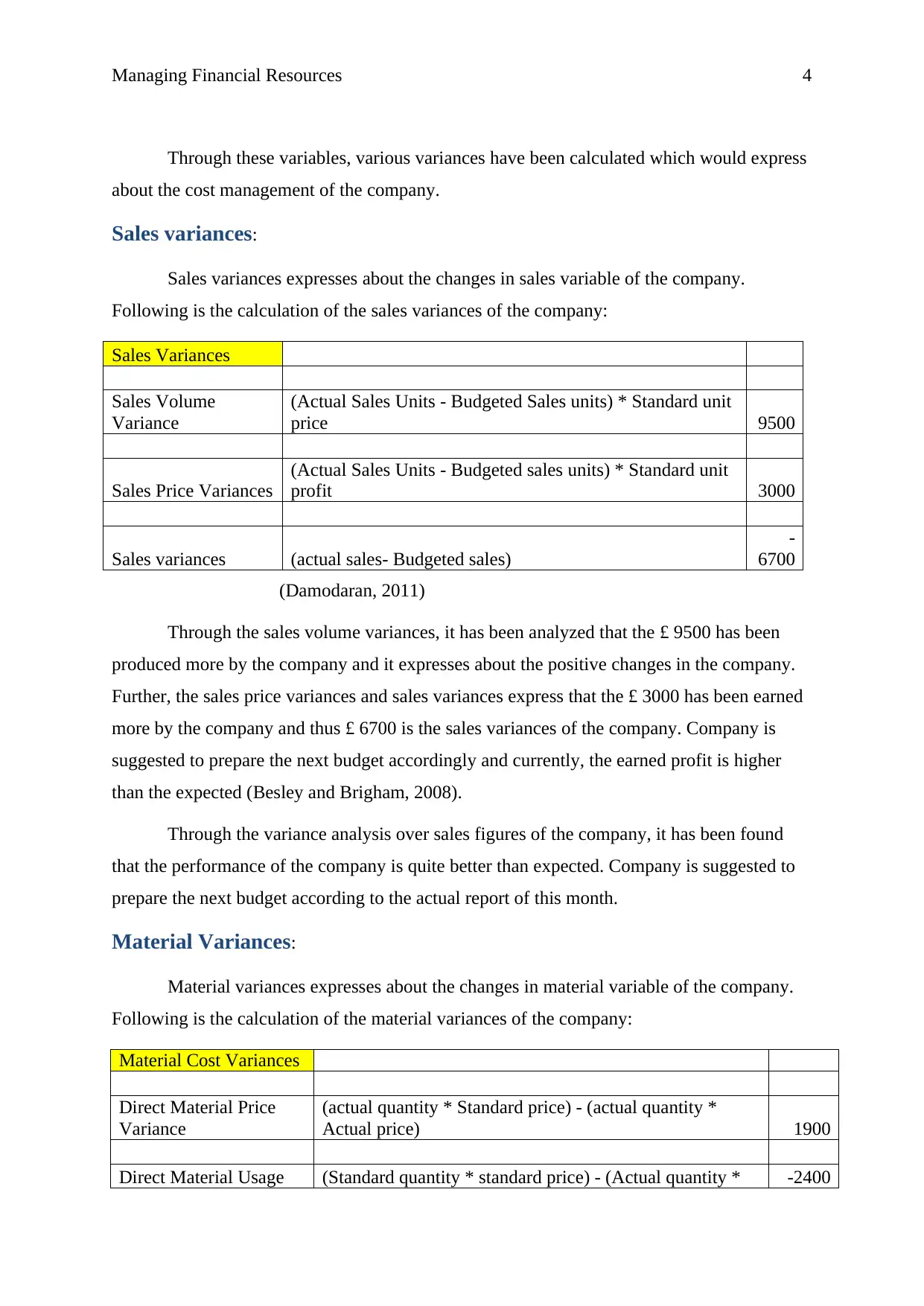
Managing Financial Resources 4
Through these variables, various variances have been calculated which would express
about the cost management of the company.
Sales variances:
Sales variances expresses about the changes in sales variable of the company.
Following is the calculation of the sales variances of the company:
Sales Variances
Sales Volume
Variance
(Actual Sales Units - Budgeted Sales units) * Standard unit
price 9500
Sales Price Variances
(Actual Sales Units - Budgeted sales units) * Standard unit
profit 3000
Sales variances (actual sales- Budgeted sales)
-
6700
(Damodaran, 2011)
Through the sales volume variances, it has been analyzed that the £ 9500 has been
produced more by the company and it expresses about the positive changes in the company.
Further, the sales price variances and sales variances express that the £ 3000 has been earned
more by the company and thus £ 6700 is the sales variances of the company. Company is
suggested to prepare the next budget accordingly and currently, the earned profit is higher
than the expected (Besley and Brigham, 2008).
Through the variance analysis over sales figures of the company, it has been found
that the performance of the company is quite better than expected. Company is suggested to
prepare the next budget according to the actual report of this month.
Material Variances:
Material variances expresses about the changes in material variable of the company.
Following is the calculation of the material variances of the company:
Material Cost Variances
Direct Material Price
Variance
(actual quantity * Standard price) - (actual quantity *
Actual price) 1900
Direct Material Usage (Standard quantity * standard price) - (Actual quantity * -2400
Through these variables, various variances have been calculated which would express
about the cost management of the company.
Sales variances:
Sales variances expresses about the changes in sales variable of the company.
Following is the calculation of the sales variances of the company:
Sales Variances
Sales Volume
Variance
(Actual Sales Units - Budgeted Sales units) * Standard unit
price 9500
Sales Price Variances
(Actual Sales Units - Budgeted sales units) * Standard unit
profit 3000
Sales variances (actual sales- Budgeted sales)
-
6700
(Damodaran, 2011)
Through the sales volume variances, it has been analyzed that the £ 9500 has been
produced more by the company and it expresses about the positive changes in the company.
Further, the sales price variances and sales variances express that the £ 3000 has been earned
more by the company and thus £ 6700 is the sales variances of the company. Company is
suggested to prepare the next budget accordingly and currently, the earned profit is higher
than the expected (Besley and Brigham, 2008).
Through the variance analysis over sales figures of the company, it has been found
that the performance of the company is quite better than expected. Company is suggested to
prepare the next budget according to the actual report of this month.
Material Variances:
Material variances expresses about the changes in material variable of the company.
Following is the calculation of the material variances of the company:
Material Cost Variances
Direct Material Price
Variance
(actual quantity * Standard price) - (actual quantity *
Actual price) 1900
Direct Material Usage (Standard quantity * standard price) - (Actual quantity * -2400
Paraphrase This Document
Need a fresh take? Get an instant paraphrase of this document with our AI Paraphraser
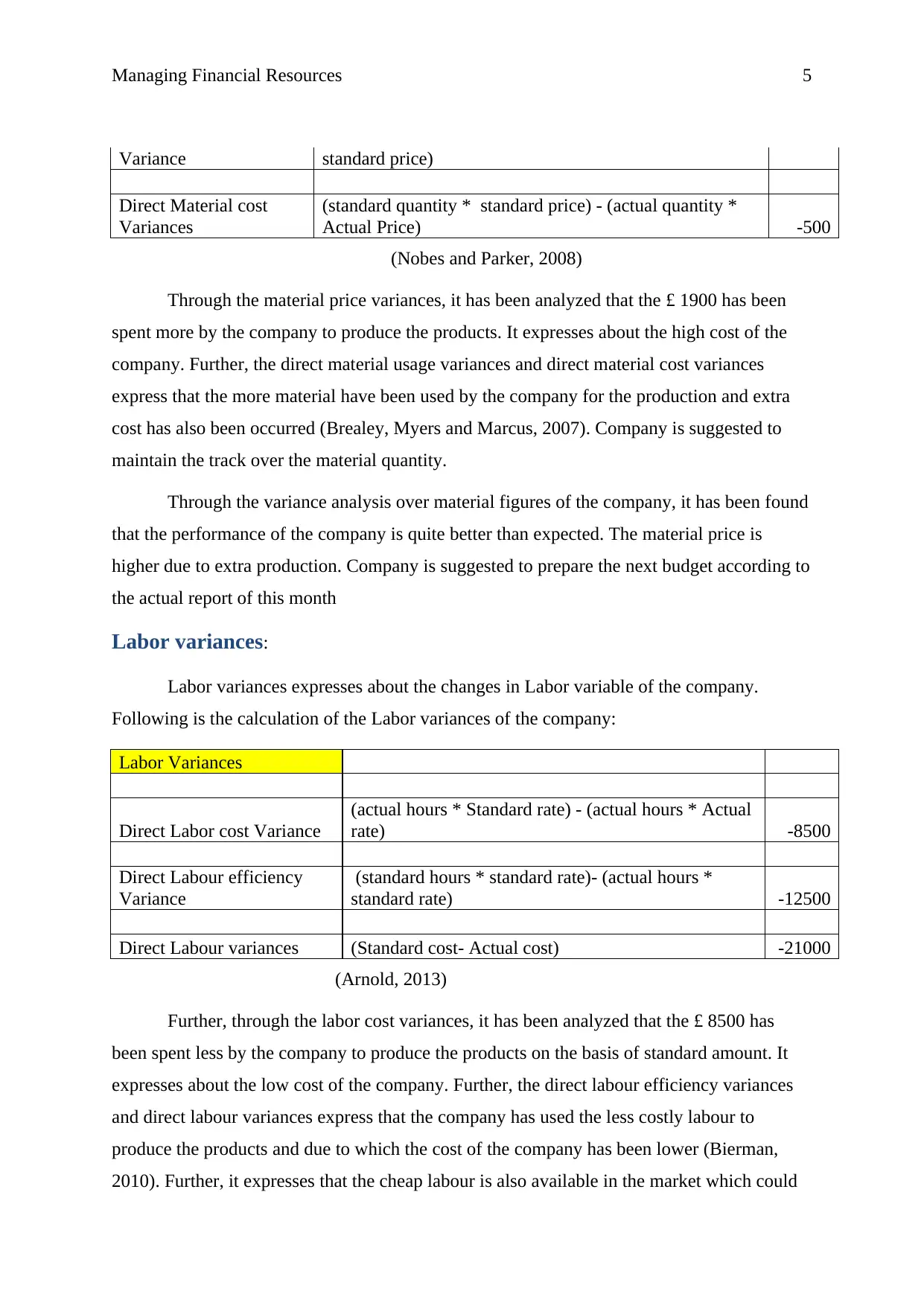
Managing Financial Resources 5
Variance standard price)
Direct Material cost
Variances
(standard quantity * standard price) - (actual quantity *
Actual Price) -500
(Nobes and Parker, 2008)
Through the material price variances, it has been analyzed that the £ 1900 has been
spent more by the company to produce the products. It expresses about the high cost of the
company. Further, the direct material usage variances and direct material cost variances
express that the more material have been used by the company for the production and extra
cost has also been occurred (Brealey, Myers and Marcus, 2007). Company is suggested to
maintain the track over the material quantity.
Through the variance analysis over material figures of the company, it has been found
that the performance of the company is quite better than expected. The material price is
higher due to extra production. Company is suggested to prepare the next budget according to
the actual report of this month
Labor variances:
Labor variances expresses about the changes in Labor variable of the company.
Following is the calculation of the Labor variances of the company:
Labor Variances
Direct Labor cost Variance
(actual hours * Standard rate) - (actual hours * Actual
rate) -8500
Direct Labour efficiency
Variance
(standard hours * standard rate)- (actual hours *
standard rate) -12500
Direct Labour variances (Standard cost- Actual cost) -21000
(Arnold, 2013)
Further, through the labor cost variances, it has been analyzed that the £ 8500 has
been spent less by the company to produce the products on the basis of standard amount. It
expresses about the low cost of the company. Further, the direct labour efficiency variances
and direct labour variances express that the company has used the less costly labour to
produce the products and due to which the cost of the company has been lower (Bierman,
2010). Further, it expresses that the cheap labour is also available in the market which could
Variance standard price)
Direct Material cost
Variances
(standard quantity * standard price) - (actual quantity *
Actual Price) -500
(Nobes and Parker, 2008)
Through the material price variances, it has been analyzed that the £ 1900 has been
spent more by the company to produce the products. It expresses about the high cost of the
company. Further, the direct material usage variances and direct material cost variances
express that the more material have been used by the company for the production and extra
cost has also been occurred (Brealey, Myers and Marcus, 2007). Company is suggested to
maintain the track over the material quantity.
Through the variance analysis over material figures of the company, it has been found
that the performance of the company is quite better than expected. The material price is
higher due to extra production. Company is suggested to prepare the next budget according to
the actual report of this month
Labor variances:
Labor variances expresses about the changes in Labor variable of the company.
Following is the calculation of the Labor variances of the company:
Labor Variances
Direct Labor cost Variance
(actual hours * Standard rate) - (actual hours * Actual
rate) -8500
Direct Labour efficiency
Variance
(standard hours * standard rate)- (actual hours *
standard rate) -12500
Direct Labour variances (Standard cost- Actual cost) -21000
(Arnold, 2013)
Further, through the labor cost variances, it has been analyzed that the £ 8500 has
been spent less by the company to produce the products on the basis of standard amount. It
expresses about the low cost of the company. Further, the direct labour efficiency variances
and direct labour variances express that the company has used the less costly labour to
produce the products and due to which the cost of the company has been lower (Bierman,
2010). Further, it expresses that the cheap labour is also available in the market which could
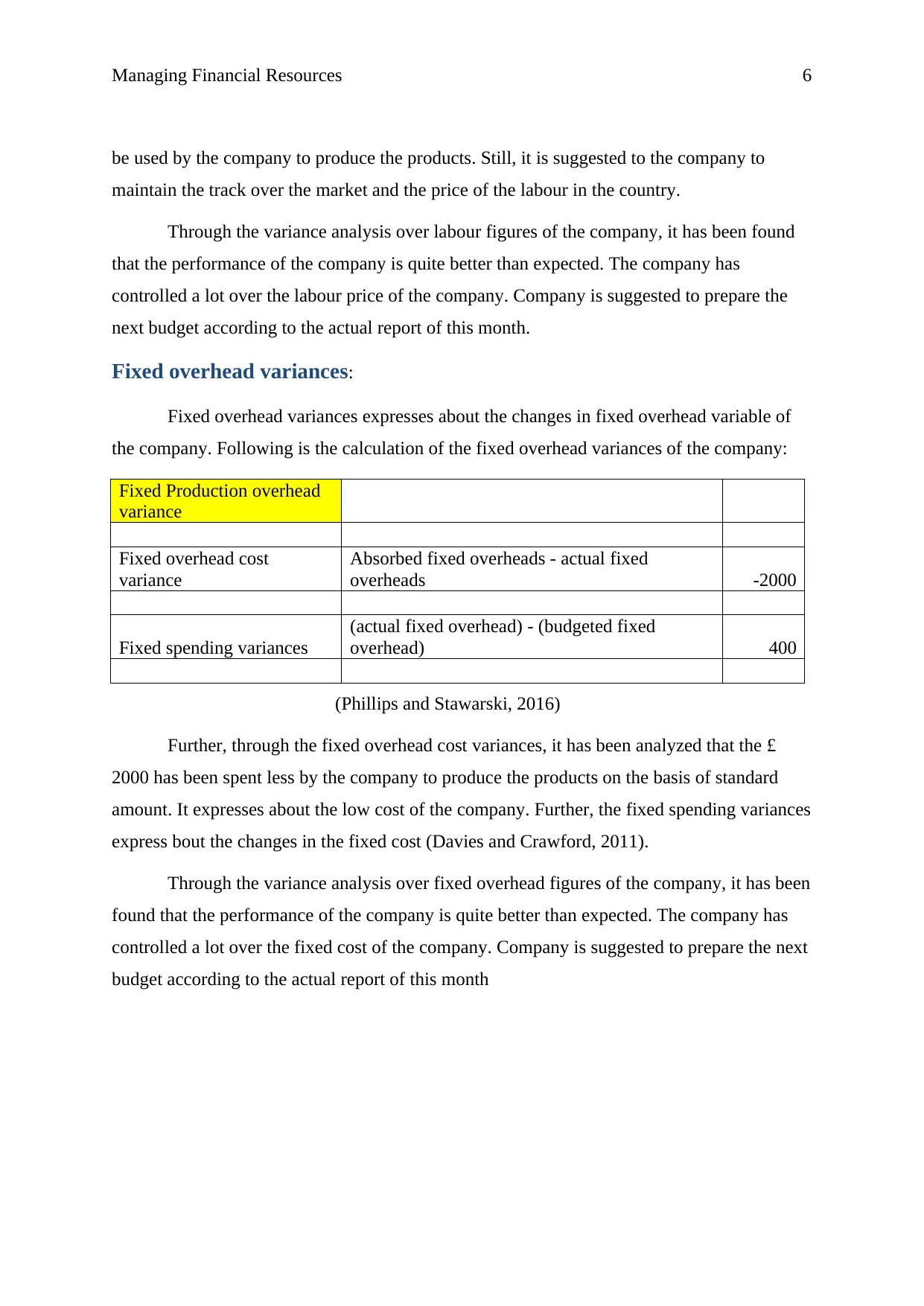
Managing Financial Resources 6
be used by the company to produce the products. Still, it is suggested to the company to
maintain the track over the market and the price of the labour in the country.
Through the variance analysis over labour figures of the company, it has been found
that the performance of the company is quite better than expected. The company has
controlled a lot over the labour price of the company. Company is suggested to prepare the
next budget according to the actual report of this month.
Fixed overhead variances:
Fixed overhead variances expresses about the changes in fixed overhead variable of
the company. Following is the calculation of the fixed overhead variances of the company:
Fixed Production overhead
variance
Fixed overhead cost
variance
Absorbed fixed overheads - actual fixed
overheads -2000
Fixed spending variances
(actual fixed overhead) - (budgeted fixed
overhead) 400
(Phillips and Stawarski, 2016)
Further, through the fixed overhead cost variances, it has been analyzed that the £
2000 has been spent less by the company to produce the products on the basis of standard
amount. It expresses about the low cost of the company. Further, the fixed spending variances
express bout the changes in the fixed cost (Davies and Crawford, 2011).
Through the variance analysis over fixed overhead figures of the company, it has been
found that the performance of the company is quite better than expected. The company has
controlled a lot over the fixed cost of the company. Company is suggested to prepare the next
budget according to the actual report of this month
be used by the company to produce the products. Still, it is suggested to the company to
maintain the track over the market and the price of the labour in the country.
Through the variance analysis over labour figures of the company, it has been found
that the performance of the company is quite better than expected. The company has
controlled a lot over the labour price of the company. Company is suggested to prepare the
next budget according to the actual report of this month.
Fixed overhead variances:
Fixed overhead variances expresses about the changes in fixed overhead variable of
the company. Following is the calculation of the fixed overhead variances of the company:
Fixed Production overhead
variance
Fixed overhead cost
variance
Absorbed fixed overheads - actual fixed
overheads -2000
Fixed spending variances
(actual fixed overhead) - (budgeted fixed
overhead) 400
(Phillips and Stawarski, 2016)
Further, through the fixed overhead cost variances, it has been analyzed that the £
2000 has been spent less by the company to produce the products on the basis of standard
amount. It expresses about the low cost of the company. Further, the fixed spending variances
express bout the changes in the fixed cost (Davies and Crawford, 2011).
Through the variance analysis over fixed overhead figures of the company, it has been
found that the performance of the company is quite better than expected. The company has
controlled a lot over the fixed cost of the company. Company is suggested to prepare the next
budget according to the actual report of this month
⊘ This is a preview!⊘
Do you want full access?
Subscribe today to unlock all pages.

Trusted by 1+ million students worldwide
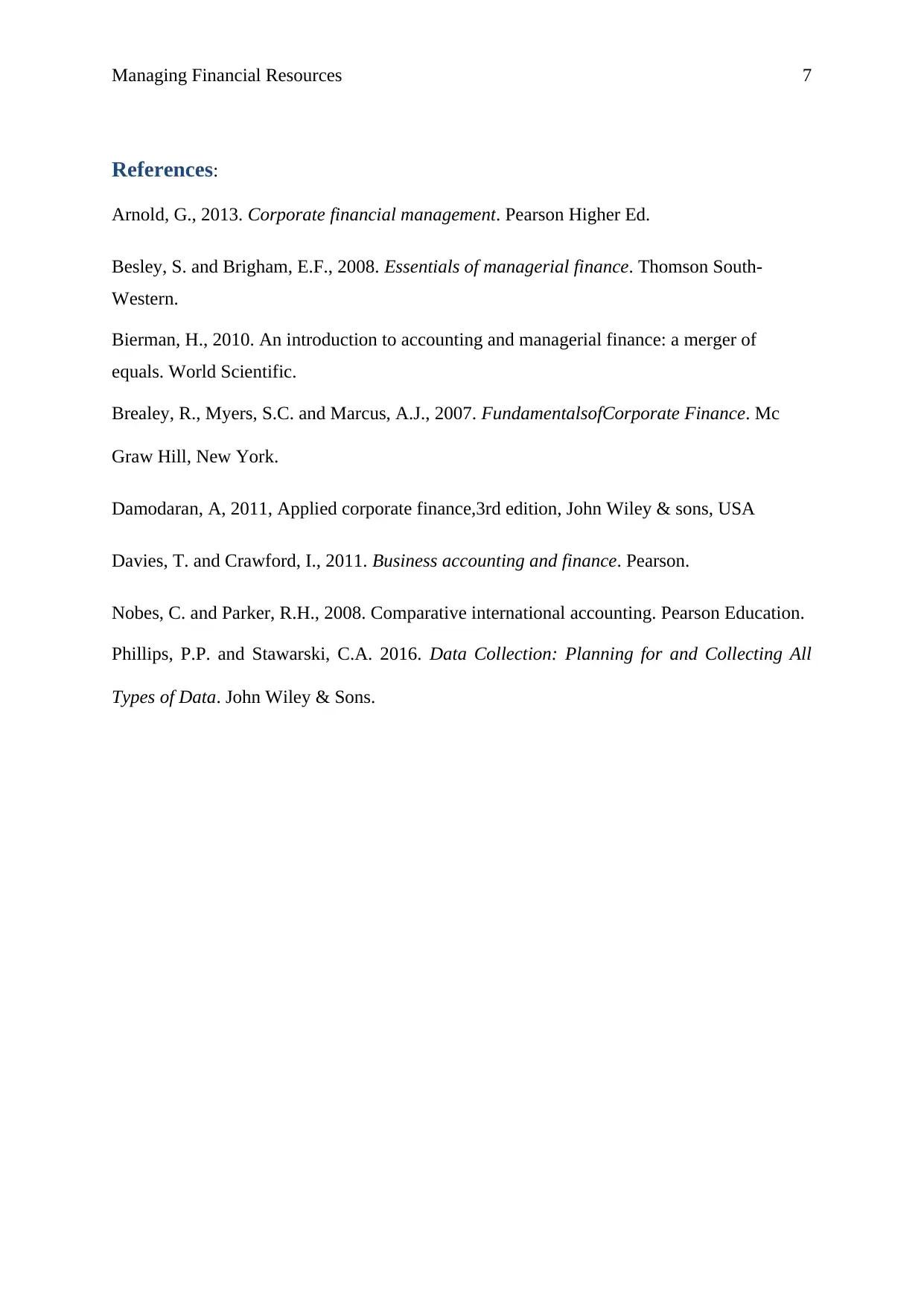
Managing Financial Resources 7
References:
Arnold, G., 2013. Corporate financial management. Pearson Higher Ed.
Besley, S. and Brigham, E.F., 2008. Essentials of managerial finance. Thomson South-
Western.
Bierman, H., 2010. An introduction to accounting and managerial finance: a merger of
equals. World Scientific.
Brealey, R., Myers, S.C. and Marcus, A.J., 2007. FundamentalsofCorporate Finance. Mc
Graw Hill, New York.
Damodaran, A, 2011, Applied corporate finance,3rd edition, John Wiley & sons, USA
Davies, T. and Crawford, I., 2011. Business accounting and finance. Pearson.
Nobes, C. and Parker, R.H., 2008. Comparative international accounting. Pearson Education.
Phillips, P.P. and Stawarski, C.A. 2016. Data Collection: Planning for and Collecting All
Types of Data. John Wiley & Sons.
References:
Arnold, G., 2013. Corporate financial management. Pearson Higher Ed.
Besley, S. and Brigham, E.F., 2008. Essentials of managerial finance. Thomson South-
Western.
Bierman, H., 2010. An introduction to accounting and managerial finance: a merger of
equals. World Scientific.
Brealey, R., Myers, S.C. and Marcus, A.J., 2007. FundamentalsofCorporate Finance. Mc
Graw Hill, New York.
Damodaran, A, 2011, Applied corporate finance,3rd edition, John Wiley & sons, USA
Davies, T. and Crawford, I., 2011. Business accounting and finance. Pearson.
Nobes, C. and Parker, R.H., 2008. Comparative international accounting. Pearson Education.
Phillips, P.P. and Stawarski, C.A. 2016. Data Collection: Planning for and Collecting All
Types of Data. John Wiley & Sons.
1 out of 7
Related Documents
Your All-in-One AI-Powered Toolkit for Academic Success.
+13062052269
info@desklib.com
Available 24*7 on WhatsApp / Email
![[object Object]](/_next/static/media/star-bottom.7253800d.svg)
Unlock your academic potential
Copyright © 2020–2025 A2Z Services. All Rights Reserved. Developed and managed by ZUCOL.




